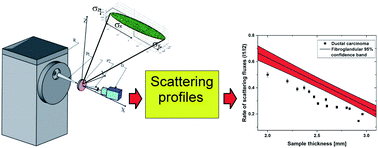Breast cancer analysis by confocal energy dispersive micro-XRD
Abstract
In this work, the confocal energy dispersive micro-XRD technique has been employed to efficiently study differences between normal and malignant carcinomas in breast tissues. This technique has been implemented with low angular divergence glass monocapillaries in the excitation and detection channels. The microdiffractometer operates with a scattering angle of (20.3 ± 0.9)° that defines a cross section for analysis (0.178 mm × 0.175 mm), with a depth resolution of 1.18 mm. The obtained momentum transfer resolution between 3.9 and 10.9% was found to be highly useful to identify the scattering profiles of adipose tissues without any data processing. Differentiation between tissues with similar scattering profiles, such as fibroglandular and neoplastic tissues, has been achieved by processing the spectra within the framework of diffraction theory for scattering intensity. The obtained results allowed the development of a deterministic diagnostic model based on the evaluation of the depth profiles by confocal micro-XRD. In this model, the modulation of the scattering profiles caused by X-ray attenuation was analyzed to differentiate neoplastic tissues. The spatial resolution of the technique was the key aspect of the process, helping to detect variations in X-ray attenuation and to select uniform volume of analysis without superimposed scattering profiles.



 Please wait while we load your content...
Please wait while we load your content...